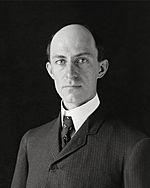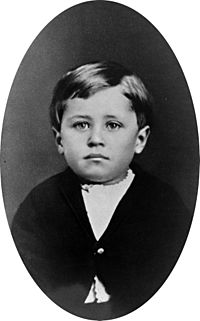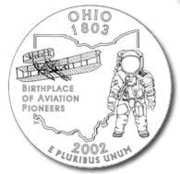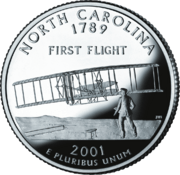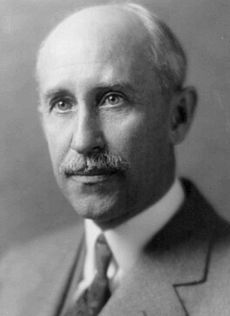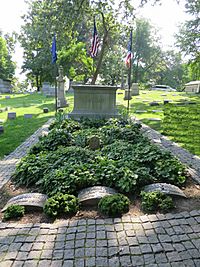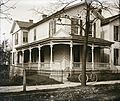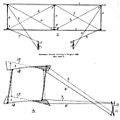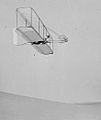Wright brothers facts for kids
Quick facts for kids
The Wright brothers
|
|
|---|---|
| Nationality | American |
| Other names | Will and Orv The Bishop's boys |
| Known for | Inventing, building, and flying the world's first successful motor-operated airplane, the Wright Flyer |
| Home town | Dayton, Ohio |
| Parent(s) | Milton Wright Susan Catherine Koerner Wright |
| Relatives | Katharine Wright (sister) |
| Signatures Orville Wright |
|
| Born | August 19, 1871 Dayton, Ohio |
| Died | January 30, 1948 (aged 76) Dayton, Ohio |
| Cause of death | Heart attack |
| Education | 3 years high school |
| Occupation | Printer/publisher, bicycle retailer/manufacturer, airplane inventor/manufacturer, pilot trainer |
| Wilbur Wright | |
| Born | April 16, 1867 Millville, Indiana |
| Died | May 30, 1912 (aged 45) Dayton, Ohio |
| Cause of death | Typhoid fever |
| Education | 4 years high school |
| Occupation | Editor, bicycle retailer/manufacturer, airplane inventor/manufacturer, pilot trainer |
The Wright brothers, Orville and Wilbur Wright, were American inventors. They are famous for designing, building, and flying the world's first successful motor-powered airplane. This amazing event happened on December 17, 1903. They spent many years experimenting with gliders before their first powered flight. They also created the first way to steer an airplane in the air. They designed their aircraft in Dayton, Ohio. Their first test flight took place in Kitty Hawk, North Carolina.
Contents
- Growing Up: The Wright Brothers' Early Life
- How the Wright Brothers Learned to Fly
- The First Flight: A Historic Moment
- Who Flew First? Competing Claims
- State Rivalry: Ohio vs. North Carolina
- Later Years: Wilbur and Orville's Lives
- Famous Quotes from the Wright Brothers
- Interesting Facts About the Wright Brothers
- Images for kids
- See also
Growing Up: The Wright Brothers' Early Life
The Wright brothers grew up in Dayton, Ohio. They were two of seven children born to Milton Wright and Susan Catherine Koerner. Their home was full of books. Their parents encouraged them to ask questions and learn about anything that interested them. Their father, a bishop, often traveled. Because of this, the family moved many times before settling back in Dayton in 1884.
In 1878, their father brought home a toy helicopter. It was based on an invention by a French pioneer named Alphonse Pénaud. The toy was about 1 foot (30 cm) long. It was made of paper, bamboo, and cork, with a rubber band to spin its rotor. Wilbur and Orville played with it until it broke. Then, they built their own. They later said this toy sparked their interest in flying.
Both brothers went to high school. Orville left high school after his third year. Wilbur finished high school but did not get his diploma right away. This was because his family moved suddenly. He received his diploma much later, in 1994. The brothers did not go to college. Instead, they started a newspaper business. After that, they opened a shop where they built and repaired bicycles.
How the Wright Brothers Learned to Fly
By the 1890s, the Wright brothers became very interested in flight. They especially studied the gliders made by Otto Lilienthal. They began working on airplanes in their bicycle shop. They believed that controlling an airplane was the biggest challenge in flight. Lilienthal and others had died because they could not control their aircraft.
The Wright brothers solved this problem. They invented control surfaces, like a rudder, that would work in the air. They watched how birds moved their wings. They then built wings that could twist a little and move up and down slightly. They called this steering system wing-warping.
From 1900 to 1902, they built gliders in Dayton. They tested these gliders in Kitty Hawk, North Carolina. This location had strong and steady winds. They also made small versions of wings. They built a wind tunnel to test how well different wing shapes would lift an airplane.
The First Flight: A Historic Moment
In 1903, the brothers built a powered airplane. It had propellers and a small engine. This airplane, called the Wright Flyer, flew successfully on December 17, 1903. The flight happened near Kitty Hawk, North Carolina. This was the first time people ever flew a powered airplane they could control. Before this, people flew in balloons or gliders. Some flew for a very short time in planes they could not control. The brothers kept improving their design. By 1905, they had a very good plane.
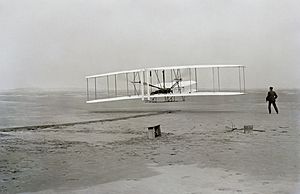
The Wright brothers kept their discovery mostly secret for a few years. They showed it to the world in 1908. They had filed a patent for their steering system on March 23, 1903. After this, they started a company to build airplanes. They had legal battles with Glenn Curtiss over who invented the airplane steering system. The Wrights believed Curtiss's aileron system was too similar to theirs.
During these legal fights, Wilbur died. Orville continued to work to protect their reputation as the first to fly. Later, he sold the airplane company. He became an important figure in aviation. He passed away in 1948.
On May 25, 1910, Orville made two special flights. First, he flew for six minutes with Wilbur as his passenger. This was the only time the Wright brothers ever flew together. They had promised their father they would never fly together. This was to make sure one brother would always be left to continue their work. Next, Orville took his 82-year-old father on a nearly seven-minute flight. This was the only time Milton Wright ever flew in a powered aircraft. The plane went up to about 350 feet (107 m). His father called out, "Higher, Orville, higher!"
Who Flew First? Competing Claims
Some people claim that the first powered flight happened before or after the Wright brothers' flight in 1903. Claims have been made for Clément Ader, Gustave Whitehead, Richard Pearse, and Karl Jatho. Their tests happened in the years leading up to and including 1903. Claims for flights after 1903 are made for Traian Vuia and Alberto Santos-Dumont.
Supporters of these other pioneers argue that the Wright brothers used certain techniques that disqualify them. These techniques included using a launch rail, skids instead of wheels, a headwind for takeoff, and a catapult after 1903. However, supporters of the Wright brothers say that their proven, repeated, controlled, and sustained flights mean they should be credited as the inventors of the airplane. This is true no matter what techniques they used.
Aviation historian C.H. Gibbs-Smith supported the Wrights' claim. He said that a barn door could "fly" for a short distance if enough power was used. He believed that the limited flight experiments of others were "powered hops" rather than fully controlled flights.
State Rivalry: Ohio vs. North Carolina
The U.S. states of Ohio and North Carolina both claim credit for the Wright brothers' inventions. Ohio claims credit because the brothers developed and built their design in Dayton. North Carolina claims credit because Kitty Hawk was the site of their first powered flight.
Ohio uses the slogan "Birthplace of Aviation" on its license plates. This slogan also recognizes other Ohio natives like astronauts John Glenn and Neil Armstrong. North Carolina uses the slogan "First In Flight" on its license plates.
The site of the first flights in North Carolina is now the Wright Brothers National Memorial. Their facilities in Ohio are part of the Dayton Aviation Heritage National Historical Park. Both states played important roles in flight history. So, neither state has an exclusive claim to the Wrights' achievement.
Despite this friendly competition, the Wrights' final bicycle shop and home were moved from Dayton to Greenfield Village in Dearborn, Michigan, in 1937. They are still there today.
Later Years: Wilbur and Orville's Lives
Wilbur Wright's Final Years
Both Wilbur and Orville never married. Wilbur once joked that he "did not have time for both a wife and an airplane." In 1909, a short silent film called Wilbur Wright and his Flying Machine was made. It is thought to be the first time aerial photography was filmed from an airplane. After a training flight in Germany in June 1911, Wilbur never flew again. He became busy with business matters for the Wright Company and dealing with lawsuits.
Wilbur spent the year before his death traveling. He spent six months in Europe dealing with business and legal issues. He urged American cities to create large public spaces near important buildings, like those in Europe. He also traveled often between New York, Washington, and Dayton. All this stress took a toll on his health. Orville said Wilbur would "come home white."
The family decided to build a new, larger house called Hawthorn Hill. Building began in Oakwood, Ohio, while Wilbur was in Europe. Katharine and Orville managed the project. Wilbur's only wish for the house was to have his own room and bathroom. The brothers hired an architectural firm to design the house. Wilbur did not live to see its completion in 1914.
He became ill on a business trip in April 1912. After returning to Dayton in early May 1912, he fell ill again and was diagnosed with typhoid fever. Wilbur died at age 45 on May 30, 1912. His father wrote in his diary that Wilbur had "An unfailing intellect, imperturbable temper, great self-reliance and as great modesty, seeing the right clearly, pursuing it steadfastly, he lived and died."
Orville Wright's Life After Wilbur
Orville became the president of the Wright Company after Wilbur's death. He won the important Collier Trophy in 1914 for developing an automatic stabilizer for their planes. Orville did not enjoy business as much as Wilbur. He sold the company in 1915. The Wright Company then became part of Wright-Martin in 1916.
After living at their home on 7 Hawthorn Street for 42 years, Orville, Katharine, and their father, Milton, moved to Hawthorn Hill in 1914. Milton died in his sleep on April 3, 1917, at age 88. He was very active until his death, enjoying reading, writing, and morning walks. He even marched in a women's suffrage parade with Orville and Katharine.
Orville made his last flight as a pilot in 1918. He retired from business and became an important figure in aviation. He served on various official committees, including the National Advisory Committee for Aeronautics (NACA).
Katharine married Henry Haskell in 1926. Orville was very upset and felt betrayed by his sister. He refused to attend the wedding or talk to her. He finally agreed to see her just before she died of pneumonia on March 3, 1929.
Orville Wright served on the NACA for 28 years. In 1930, he received the first Daniel Guggenheim Medal. In 1936, he was elected to the National Academy of Sciences. In 1939, President Franklin Delano Roosevelt declared Orville's birthday as National Aviation Day. This is a national holiday that celebrates the development of aviation.
On April 19, 1944, a Lockheed Constellation airplane flew from California to Washington, D.C. It was piloted by Howard Hughes and TWA president Jack Frye. On the return trip, the plane stopped at Wright Field. Orville Wright took his last airplane flight there, more than 40 years after his first historic flight. He may have even briefly handled the controls. He said that the wingspan of the Constellation was longer than the distance of his first flight.
Orville's last major project was overseeing the restoration of the 1905 Wright Flyer III. Historians describe this as the first practical airplane.
Years later, Orville expressed sadness about the death and destruction caused by bombers in World War II. He said, "We dared to hope we had invented something that would bring lasting peace to the earth. But we were wrong ... No, I don't have any regrets about my part in the invention of the airplane, though no one could deplore more than I do the destruction it has caused. I feel about the airplane much the same as I do in regard to fire. That is, I regret all the terrible damage caused by fire, but I think it is good for the human race that someone discovered how to start fires and that we have learned how to put fire to thousands of important uses."
Orville died at age 76 on January 30, 1948. This was over 35 years after his brother. He lived from the time of horse-and-buggies to the beginning of supersonic flight. Both brothers are buried in the family plot at Woodland Cemetery, Dayton, Ohio. John T. Daniels, the Coast Guardsman who took their famous first flight photo, died the day after Orville.
Famous Quotes from the Wright Brothers
Orville Wright's Wisdom
- “If we worked on the assumption that what is accepted as true really is true, then there would be little hope for advance.”
- “We were lucky enough to grow up in an environment where there was always much encouragement to children to pursue intellectual interests; to investigate whatever aroused curiosity.”
Wilbur Wright's Thoughts
- “It is possible to fly without motors, but not without knowledge and skill.”
- “Men become wise just as they become rich, more by what they save than by what they receive.”
Interesting Facts About the Wright Brothers
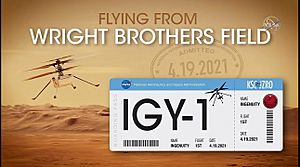
- None of the Wright children had middle names. Their father tried to give them unique first names. Wilbur was named for Willbur Fisk, and Orville for Orville Dewey. Both were clergymen their father admired.
- To their friends, they were known as "Will" and "Orv." In Dayton, their neighbors simply called them "the Bishop's kids" or "the Bishop's boys."
- NASA named the first Martian take-off and landing area for the 2021 Ingenuity helicopter "Wright Brothers Field." The helicopter carries a small piece of wing fabric from the 1903 Wright Flyer attached to a cable.
- In 1969, Neil Armstrong carried a similar Wright Flyer artifact to the Moon. This happened in the Lunar Module Eagle during Apollo 11.
Images for kids
-
Wright brothers at the Belmont Park Aviation Meet in 1910
-
A Wright engine, serial number 17, circa 1910, on display at the New England Air Museum
-
Elwood Doherty, a Curtiss pilot, coaxes the structurally modified Langley Aerodrome into the air above the surface of Keuka Lake near Hammondsport, New York, September 17, 1914.
-
Original 1903 Wright Flyer in the National Air and Space Museum in Washington, D.C.
See also
 In Spanish: Hermanos Wright para niños
In Spanish: Hermanos Wright para niños



